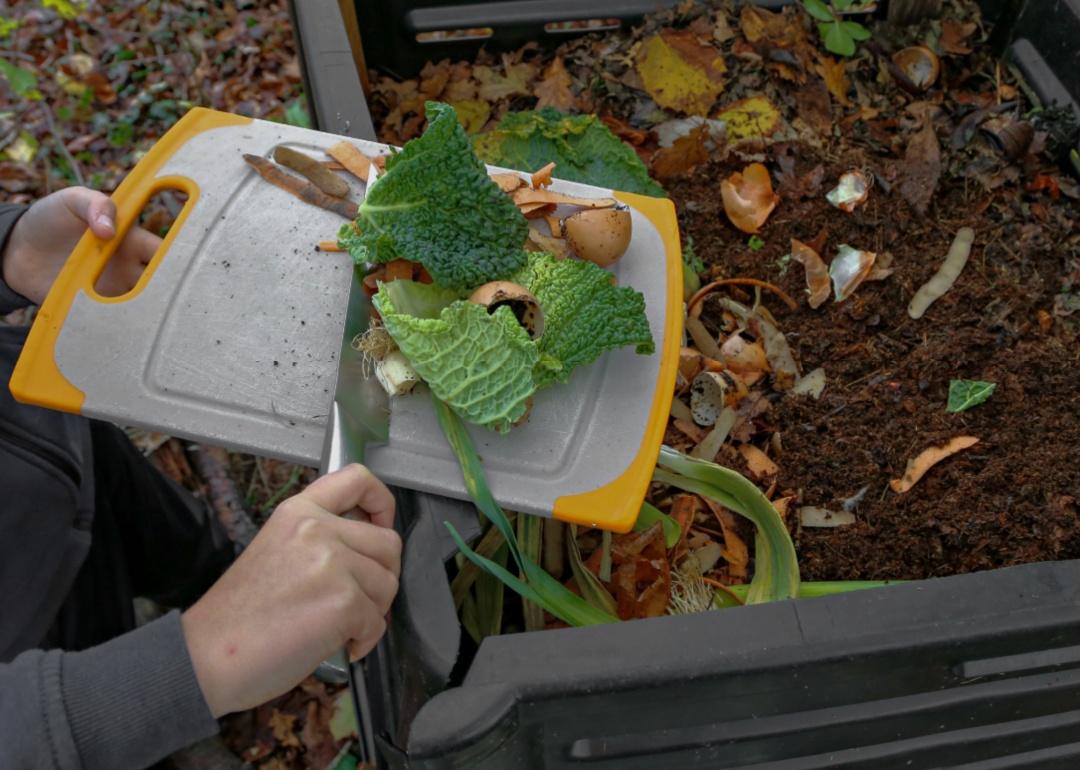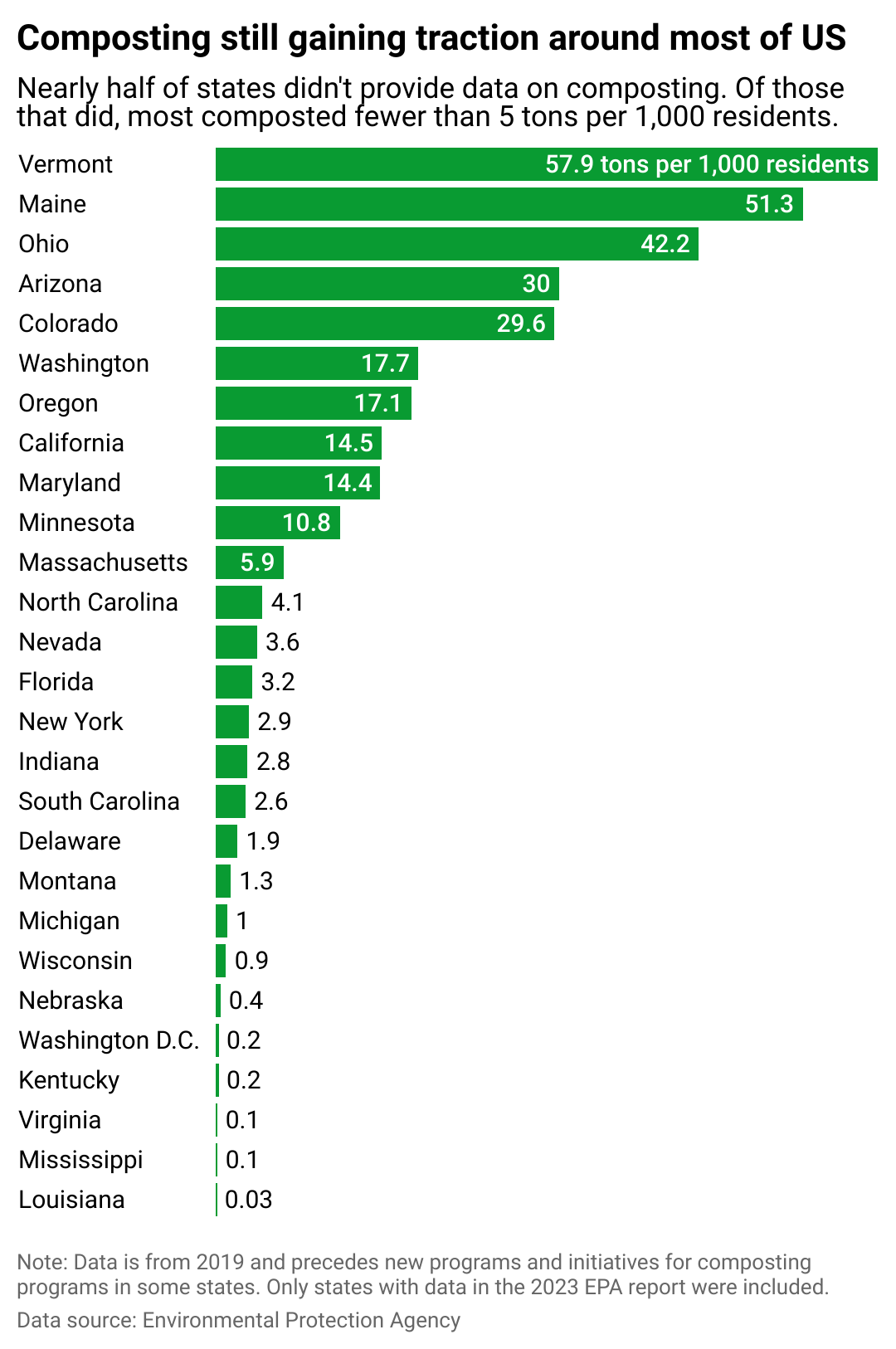
This story originally appeared on Machinery Partner and was produced and distributed in partnership with Stacker Studio.
How much Montana composts
Americans composted about 3.3 million tons of food waste in 2019, according to the Environmental Protection Agency's most recent estimates. Of that, 1,418 tons were in Montana.
That may seem like a lot, but consider that between residential areas, commercial food service, and food retail, Americans generated 66.2 million tons of wasted food that same year. That means about 5% of the nation's food waste is composted, with the rest going to landfills, where food waste is the most commonly found material. Food decomposes much slower in landfills than when composted. Lacking oxygen, it also produces methane, a harmful greenhouse gas.
While these statistics are grim from a sustainability standpoint, they do convey an opportunity for new composting companies and systems to arise.
Machinery Partner analyzed food composting in Montana as part of a larger analysis conducted to find where there is an appetite for composting and where composting infrastructure may be lacking. This analysis also includes a visualization looking at the quantity of compost per capita, using data collected by the Environmental Protection Agency. The data was released in 2023 but represents 2019, so it precedes new programs and initiatives for composting programs in some states.
Composting is a natural recycling process that incorporates insects, bacteria, and fungi to break down yard waste and food scraps, returning their nutrients to the soil and providing for new plant life. Composting reduces greenhouse gas emissions, replenishes organic materials in soil, creates jobs, and reduces costs for traditional garbage and landfill management.
In practice, composting can take many different forms, from burying food scraps in the backyard to municipal and commercial services that pick up compost and yard waste bins and take them to processing facilities similar to other U.S. trash collection systems.
Montana composted about 1.3 tons per 1,000 residents in 2019, ranking No. 19 in the nation, out of 27 states (plus Washington D.C.) with data available.
A BioCycle study identified over 200 full-scale composting facilities in the U.S., the vast majority of which were privately owned or operated. The organics recycling publication also found that between 2021 and 2023, there was a 49% increase in the number of households with access to residential food waste collection programs, though these services reach just 12% of homes. The presence of backyard composting and small community sites is much harder to quantify.
In January, the Department of Agriculture announced a $11.5 million investment into composting and food waste diversion programs across 23 states through the American Rescue Plan Act of 2021. In a continuation of this effort, the USDA is in the process of selecting two-year pilot projects for composting and food waste reduction to support, largely from local and tribal governments and organizations, which would launch in 2025. These funds build on over $12 million in similar investments since 2020.

Few states commit to composting in earnest as of 2019
States like Vermont, Maine, and Ohio already had relatively robust composting programs as of 2019, the EPA data shows. Some low-ranked states, like Virginia, received federal dollars in recent years to increase composting capacity. Many states lacked data for the EPA composting report. In some sectors and regions, this data simply hasn't been collected historically, while in others, data updates are few and far between.
The more recent BioCycle study found that about 50% of U.S. full-scale food waste composting facilities were located in seven states: California, New York, Colorado, Pennsylvania, Washington, Texas, and North Carolina. Residential collection services were most prevalent in the West and Northeast, though some were available in states interspersed throughout other regions. The highest volume of programs was found in California, Illinois, New York, and Minnesota. This limited coverage implies a vast population of would-be composters and many opportunities for new private and municipal services.
With access to continued public investments, savings opportunities, and awareness of the environmental impact, states across the country are expanding composting infrastructure. In 2015, the EPA and USDA planned to cut food loss and waste in half by 2030—reducing waste from 328 pounds per person per year to 164 pounds. By 2019, the country had achieved a 6% increase from the original baseline, meaning there's substantially more composting work to come.
Considering this increase, there are evermore opportunities for individuals to learn about composting in their communities and for prospective or existing businesses to fill the growing demand for composting services across the country.
This story features data reporting and writing by Paxtyn Merten and is part of a series utilizing data automation across 27 states and Washington D.C.



